You’ll need at least 5ATM water resistance for pool swimming and 10ATM for open-water activities. Choose sapphire glass or Gorilla Glass for scratch protection, plus titanium or marine-grade materials for saltwater durability. Compare battery life—premium models like Garmin Enduro 3 offer 90 days, while budget options provide 6-10 days. Verify accurate heart rate monitoring and GPS tracking capabilities underwater. Check swim stroke recognition, smartphone compatibility, and warranty coverage that includes water damage protection. These essential considerations will guide you toward the most thorough selection strategies.
Evaluate Water Resistance Ratings for Swimming Activities
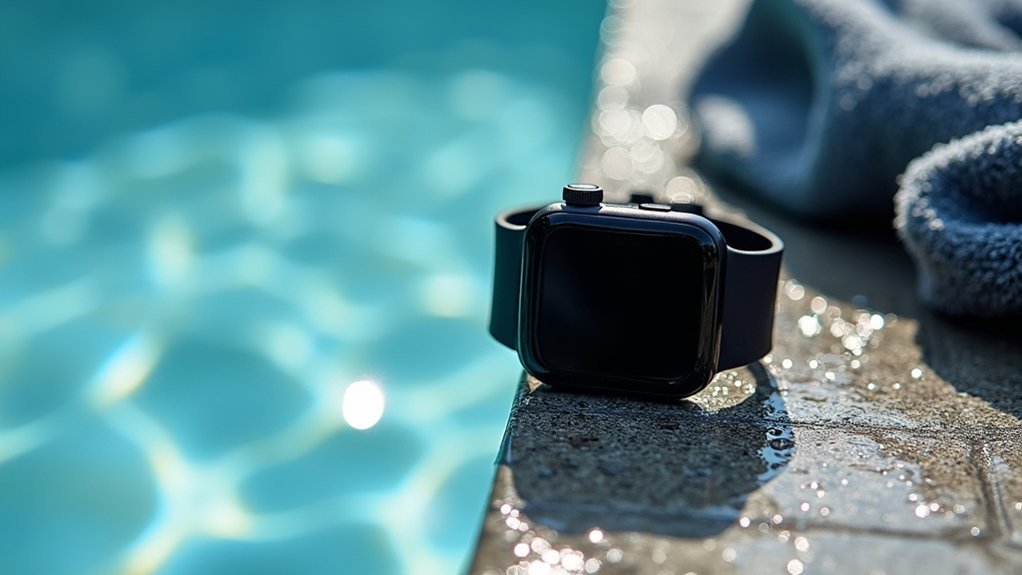
When selecting a waterproof fitness watch for swimming, you’ll need to understand that water resistance ratings measure pressure tolerance in atmospheres (ATM) rather than actual depth limits.
A 3ATM rating protects against splashes but isn’t suitable for swimming. You’ll want at least 5ATM for pool swimming, which handles surface-level activities and brief submersion safely. For open-water swimming, expect to pay higher costs as these features typically require more advanced technology and GPS functionality.
If you’re into high-speed water sports or extended swimming sessions, consider 10ATM ratings for greater protection.
Prioritize Scratch-Resistant Materials and Rugged Construction
When you’re investing in a waterproof fitness watch, the materials used directly impact how well it’ll withstand daily abuse and extreme conditions.
You’ll want to look for scratch-resistant options like sapphire glass or Corning Gorilla Glass, paired with durable case materials such as titanium or aerospace-grade aluminum.
The construction quality standards determine whether your watch survives years of workouts, water activities, and accidental impacts without showing wear. Premium options like the Garmin fēnix 7X feature rugged design specifically engineered for serious athletes who demand maximum durability during outdoor activities.
Material Types Matter
Durability separates exceptional waterproof fitness watches from mediocre ones that won’t survive your toughest workouts.
You’ll want sapphire glass for maximum scratch resistance, especially in abrasive underwater environments. Premium models like Apple Watch Ultra 2 and Coros Apex 2 Pro use this top-tier material alongside titanium cases that resist saltwater corrosion while staying lightweight.
Consider stainless steel bezels for added robustness, though they’ll increase weight. Fiber-reinforced polymer offers excellent impact resistance without bulk.
You’ll find Corning Gorilla Glass provides solid scratch protection at lower price points. Choose watches combining metal and advanced polymers for peak durability.
Reinforced glass with metal frames outperforms plastic cases in aquatic environments. The Apple Watch Series 8 demonstrates superior saltwater durability while maintaining user comfort during extended swimming sessions. Remember, scratch-resistant materials considerably extend your watch’s lifespan during water sports and outdoor activities.
Construction Quality Standards
Though premium materials provide the foundation, construction quality determines whether your waterproof fitness watch survives years of demanding use.
You’ll want watches meeting military-grade standards like MIL-STD-810G, which guarantee durability under extreme conditions. Look for reinforced outer casings and hardened frames that resist shocks from drops and impacts during outdoor activities.
Choose models with chemically strengthened displays using Gorilla Glass or sapphire crystal, plus raised bezels protecting the screen from direct contact with abrasive surfaces.
Verify high waterproof ratings of 5ATM or more, achieved through silicone gaskets and ultrasonic welding rather than basic adhesives. Leading fitness trackers now incorporate incident detection capabilities that automatically alert emergency contacts during accidents, adding an essential safety layer to their robust construction.
Consider marine-grade stainless steel buttons that resist corrosion, and confirm bands feature secure locking mechanisms with reinforced attachment points preventing stress failures.
Compare Battery Life Performance Across Different Models
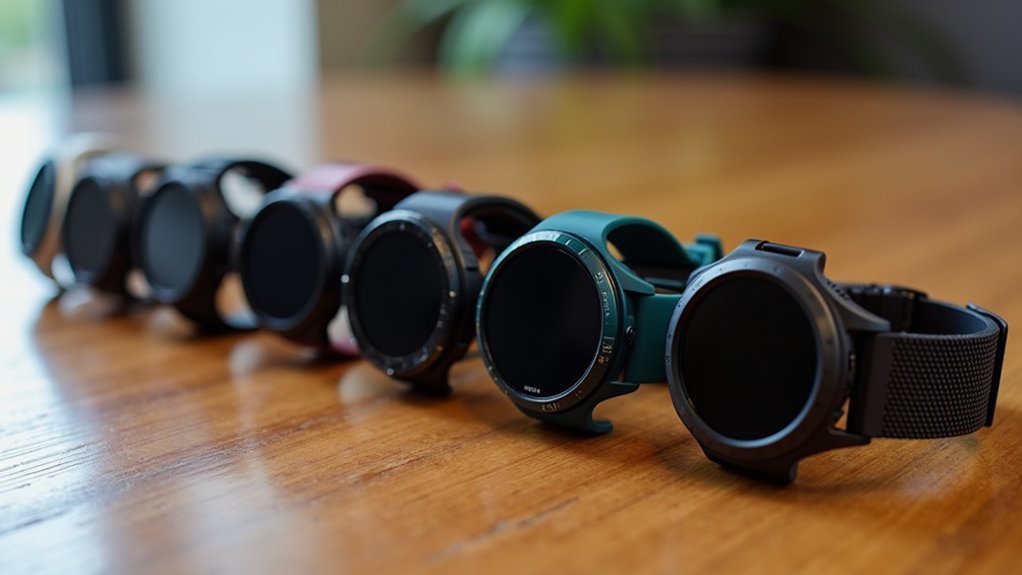
How does battery life stack up across today’s top waterproof fitness watches? You’ll find dramatic differences between models.
The Garmin Enduro 3 leads with up to 90 days using solar charging, while the fenix 8 51mm Solar offers 48 days without solar assistance. COROS VERTIX 2S delivers solid 40-day performance at a lower price point.
For GPS tracking, you’ll get 60-90 hours from the Enduro 3, 52-65 hours from the fenix 8’s dual-band GPS, and 43 hours from the VERTIX 2S.
Budget-conscious buyers can consider the Fitbit Inspire 3’s ten-day life for around $100, though premium models like Fitbit Sense 2 only last six days. The OnePlus Watch 2 stands out in the Wear OS category with four-day battery life that extends to 12 days in power saver mode.
Polar Pacer Pro offers seven days with fitness-focused features at moderate pricing.
Assess Heart Rate Monitoring Accuracy During Water Workouts
Beyond impressive battery performance, heart rate accuracy becomes a major concern when you’re swimming laps or doing water-based workouts.
Water resistance affects sensor performance, making underwater monitoring less accurate than land-based activities. You’ll find chest strap monitors traditionally reliable, but temple-based sensors like Polar Verity Sense offer superior comfort without stroke interference.
Water interferes with heart rate signals, so sensor placement matters considerably. Wrist-based optical sensors struggle underwater, while external monitors provide more accurate readings.
Different swimming strokes cause heart rate variations, and water temperature influences accuracy too. Leading brands like Garmin and Apple have developed comprehensive workout tracking systems specifically designed to address these underwater challenges.
Look for devices with specialized swimming modes and advanced algorithms that reduce interference. Clip-on monitors attached to goggles deliver better accuracy than bulky watches that disrupt your stroke technique.
Verify Smartphone Compatibility and App Integration Options
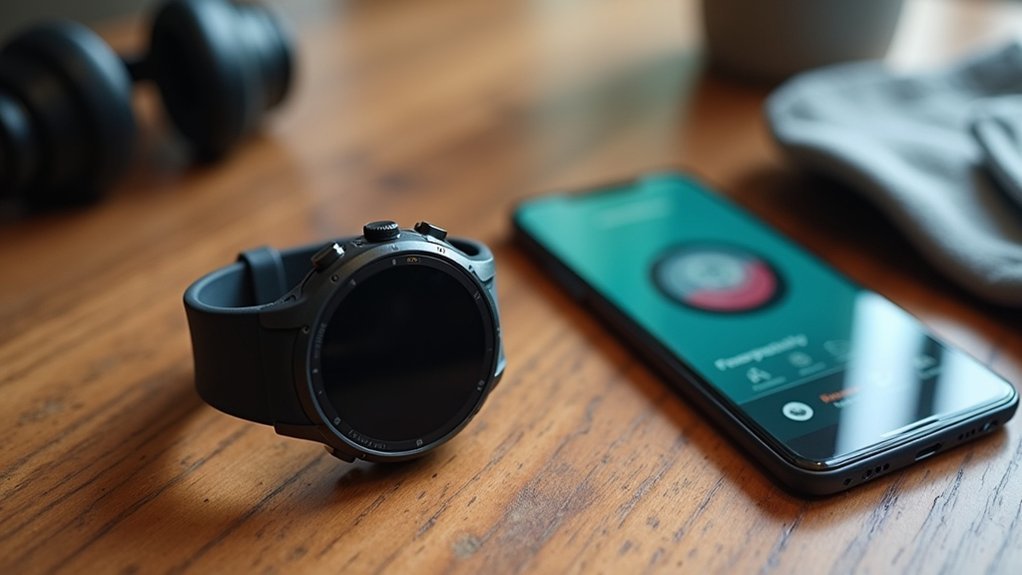
Your waterproof fitness watch’s true potential depends entirely on how well it connects with your smartphone and integrates with essential apps.
Check that your chosen watch supports your operating system—Android 6.0+ or iOS 10+—and requires Bluetooth 4.0 for reliable pairing. You’ll need the manufacturer’s proprietary app like VeryFitPro or Garmin Connect to sync data, customize settings, and view detailed analytics.
Verify third-party integration with Apple Health or Google Fit if you want consolidated health data.
Smart notifications for calls, texts, and alerts require stable app connections, while features like music control depend on OS compatibility. Most fitness trackers maintain a 10-meter range for optimal Bluetooth connectivity with your paired device.
Consider the brand’s ecosystem—Fitbit, Garmin, or Apple—for seamless multi-device syncing and enhanced functionality across your fitness tracking experience.
Analyze GPS Tracking Capabilities for Open Water Swimming
When you’re swimming in open water, you’ll need a watch that can accurately track your position and movement through GPS technology.
Your watch’s ability to capture satellite signals while your wrist breaks the water surface directly impacts how precisely it’ll measure your distance and map your swimming route.
Look for models with dual-band or multiband GPS capabilities, as they’ll provide more reliable tracking data and smoother route maps compared to basic single-frequency systems. After your swim, you can review your mapped course to analyze your performance and track training progress.
GPS Accuracy in Water
Although water naturally interferes with satellite communication, modern waterproof fitness watches have made considerable strides in maintaining GPS functionality during open water swimming.
You’ll find that devices with at least 5ATM water resistance typically maintain GPS tracking capabilities underwater. Enhanced GPS chipsets and multi-band technology considerably improve signal retention in aquatic environments.
However, you should expect accuracy limitations. GPS tracking error margins typically range around ±10% distance variance due to water surface conditions and signal obstruction. Your tracking improves when you surface frequently, allowing the device to recalibrate position.
Watches with hybrid positioning systems combining GPS, GLONASS, or Galileo satellites deliver better accuracy. Despite these limitations, GPS remains your most practical tool for open water swim navigation and route tracking.
Distance Tracking Precision
Distance tracking precision becomes the ultimate test of a waterproof fitness watch’s open water swimming capabilities.
You’ll face unique challenges as GPS signals weaken underwater and only connect when your wrist breaks the surface. Your watch must interpolate positions between these brief GPS pings, directly affecting distance accuracy.
Here’s what impacts your tracking precision:
- Multi-satellite support – Watches using GPS + GLONASS + Galileo provide better signal reliability during surface breaks.
- Sensor fusion technology – Combining accelerometer and gyroscope data with GPS improves underwater distance estimation.
- Advanced algorithms – Kalman filtering and stroke detection optimize data from multiple sensors for smoother, more accurate readings.
Many swimmers enhance their distance tracking by pairing their watch with smart swimming goggles that display GPS data directly in their field of vision for immediate feedback.
Route Mapping Features
How effectively does your waterproof fitness watch translate those intermittent GPS signals into meaningful route maps? Modern open water swim modes use sophisticated algorithms to process GPS data captured during brief surface exposure, creating breadcrumb trail maps that visually represent your swim routes. These algorithms compensate for underwater signal loss by interpolating data when your wrist’s submerged, generating surprisingly accurate path tracking.
| Feature | Benefit |
|---|---|
| Visual route playback | Evaluate swim efficiency and patterns |
| Segmented splits | Track pace every 100-500 meters |
| Path deviation analysis | Identify current effects and navigation errors |
You’ll receive detailed metrics including swim speed, distance segments, and strategic insights for avoiding currents or optimizing turns. Multi-band GPS enhances tracking reliability in remote swimming locations where traditional GPS signals may struggle to reach your device. This GPS mapping data proves invaluable for coaching feedback and planning future open water courses.
Consider Swim Stroke Recognition and Performance Analytics
When selecting a waterproof fitness watch for swimming, you’ll want to prioritize models with advanced stroke recognition technology and thorough performance analytics. These features transform your swimming experience by providing detailed insights into your technique and progress.
Modern swim watches use accelerometers and gyroscopes to identify different stroke types, including freestyle, backstroke, breaststroke, and butterfly. They’ll track essential metrics like stroke count, pace, distance, and SWOLF scores to measure your efficiency.
Consider these key features when choosing your swimming watch:
- Accurate stroke detection – Look for proven algorithms that reliably differentiate between swimming strokes.
- Comprehensive metrics – Guarantee the watch tracks stroke count, pace, distance, and rest intervals.
- App integration – Choose models that sync with platforms like Garmin Connect, Strava, or MySwimPro for detailed analysis. For enhanced functionality, consider watches that support third-party apps like Swim.com, which can provide additional metrics and community features beyond the native swimming applications.
Balance Budget Requirements With Essential Feature Sets
You’ll need to identify which waterproof features matter most for your specific needs and budget constraints.
Entry-level trackers around $60 provide basic waterproofing and fitness tracking, while mid-range options near $160 add GPS and better displays.
Premium models over $400 include advanced smartwatch capabilities.
Your decision should focus on whether you’re prioritizing essential waterproof functionality, seeking balanced features and value, or justifying premium investment for thorough technology.
Entry-Level Feature Priorities
Finding the right balance between affordability and functionality requires focusing on waterproof ratings and core swimming features that deliver genuine value.
You’ll want at least a 5 ATM rating for pool and casual open-water swimming activities, which provides adequate submersion protection up to 50 meters.
Essential entry-level priorities include:
- Pool swim tracking capabilities – stroke recognition, lap counting, and distance measurement through built-in accelerometers
- 20-40 hour battery life – sufficient for regular swimming sessions and a week of moderate daily use
- Bluetooth connectivity – seamless data sync to smartphone apps for detailed post-swim analysis
You don’t need premium features like dive modes or continuous underwater GPS tracking.
Focus on reliable stroke detection for freestyle, breaststroke, backstroke, and butterfly, plus real-time swim data display during workouts. Entry-level options like the Fitbit Charge 6 offer excellent waterproof features at just $150 while providing comprehensive swim tracking capabilities.
Mid-Range Value Assessment
Mid-range waterproof fitness watches occupy the sweet spot between $150-300, delivering sophisticated swimming features without premium pricing.
You’ll find 5 ATM water resistance suitable for pool activities and open-water swimming, plus stroke tracking and automatic lap counting. Continuous heart rate monitoring pairs with multi-satellite GPS (GLONASS, Galileo, BeiDou) for accurate outdoor tracking.
These watches balance advanced features with practical battery life—some models offer 38 hours in GPS mode. You’ll get touchscreen displays with durable Corning glass, extensive activity tracking, and sleep insights.
Garmin’s Forerunner series excels in run tracking, while COROS provides premium materials at competitive prices. Smart features include payment integration, third-party app support through Connect IQ, and seamless health platform connectivity for extensive fitness monitoring.
Premium Investment Justification
While premium waterproof fitness watches command $300+ price tags, they deliver extensive value through superior 10 ATM water resistance, extended battery life exceeding 12 hours in GPS mode, and sapphire crystal durability that protects your investment for years.
You’ll maximize your investment through three key areas:
- Advanced Swimming Analytics – Stroke detection, SWOLF scoring, and multi-satellite GPS tracking provide professional-grade data for pool and open water training.
- Ecosystem Integration – Seamless syncing with Strava, Garmin Connect, and third-party platforms creates thorough training insights.
- Long-term Value – Titanium construction, regular firmware updates, and strong resale values from trusted brands like Garmin and Polar guarantee your watch remains relevant.
Premium models justify their cost through reliability, extensive health monitoring, and the ability to replace multiple devices with one versatile solution.
Check Warranty Coverage and Customer Support Services
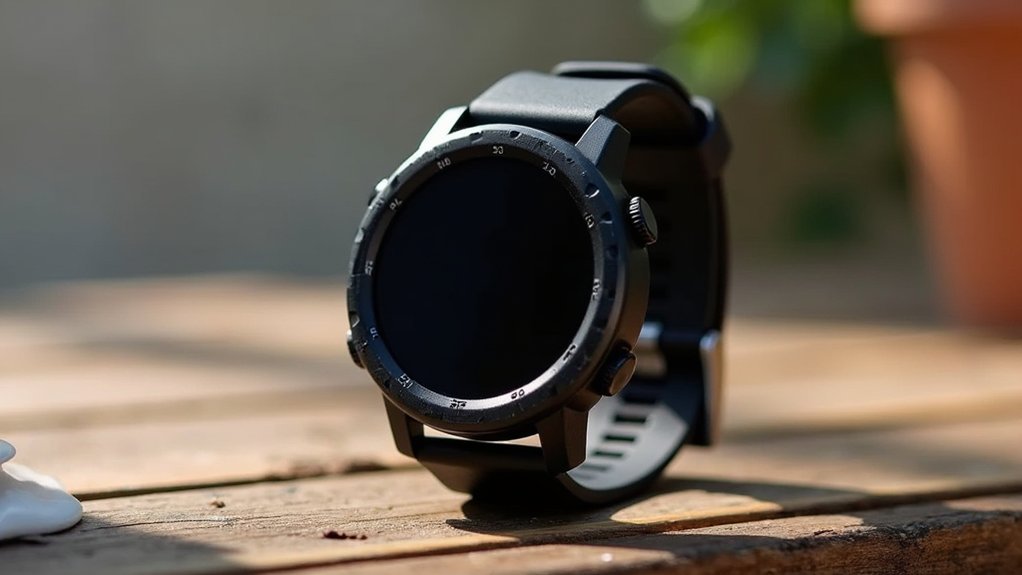
Understanding warranty coverage and customer support quality becomes essential when investing in a waterproof fitness watch, as these factors directly impact your long-term satisfaction and protection.
Premium brands like COROS and Polar typically offer 2-year warranties, while Apple, Garmin, Fitbit, and Samsung provide 1-year limited coverage. You’ll need to verify that water damage isn’t excluded, despite waterproof claims.
Standard warranties cover manufacturing defects but exclude accidental damage, so consider extended plans for drop and liquid protection. Register your device on the manufacturer’s official site to enhance support options.
Premium brands offer dedicated customer service, while entry-level brands may rely on self-service portals with slower response times. Always check the IP ratings indicated on your device to understand its actual protection level against water and liquids.
Review Additional Safety Features for Water-Based Activities
Beyond warranty protection, your waterproof fitness watch should include specialized safety features that protect you during swimming, surfing, and other aquatic activities.
You’ll want devices with accurate heart rate monitoring in water to prevent overexertion and emergency SOS features that activate during accidents or sudden impacts.
Essential safety features to prioritize:
- Heart Rate and Oxygen Monitoring – Look for sensors that maintain accuracy underwater to track your cardiovascular condition and prevent dangerous overexertion during intense aquatic workouts.
- Emergency Alert Systems – Choose watches with fall detection and SOS capabilities that can send distress signals if you experience accidents or impacts while in water.
- GPS Integration with Smartphone Connectivity – Make sure your device supports location tracking and can sync with apps to alert contacts if emergency signals are triggered. High-end models may include additional marine features like water temperature sensors and depth gauges that provide crucial environmental data for safer water activities.
Frequently Asked Questions
Can I Wear My Waterproof Fitness Watch in Saltwater and Chlorinated Pools?
You can wear waterproof fitness watches in saltwater and chlorinated pools if they’re rated 5ATM or higher. Always rinse with fresh water afterward to prevent corrosion and seal damage.
How Often Should I Clean My Waterproof Watch After Swimming Workouts?
You should clean your waterproof watch after every swimming workout. Rinse it immediately with fresh water, then use mild soap and lukewarm water to remove chlorine, salt, and sweat buildup completely.
Will My Watch’s Touchscreen Work Underwater While I’m Swimming?
Your watch’s touchscreen won’t work underwater while swimming. Most waterproof smartwatches disable touch input when wet to prevent accidents. You’ll need to use physical buttons or set up workouts beforehand.
Can I Use My Fitness Watch for Hot Tub or Sauna Sessions?
You shouldn’t use your fitness watch in hot tubs or saunas unless it’s specifically certified for heat exposure. High temperatures can damage seals, batteries, and sensors despite water resistance ratings.
What’s the Difference Between Water-Resistant and Fully Waterproof Fitness Watches?
Water-resistant watches handle splashes, rain, and brief submersion within limits. Fully waterproof fitness watches withstand prolonged underwater exposure like swimming or diving, featuring enhanced seals and higher ATM ratings for deeper water activities.
In Summary
You’ll find the perfect waterproof fitness watch by carefully weighing these essential factors against your specific needs. Don’t compromise on water resistance ratings if you’re serious about swimming, but remember that additional features like heart rate accuracy and app integration can greatly enhance your training experience. Take time to compare battery life and construction quality across different price points. Your investment in the right waterproof fitness watch will pay dividends in improved performance tracking and workout motivation.

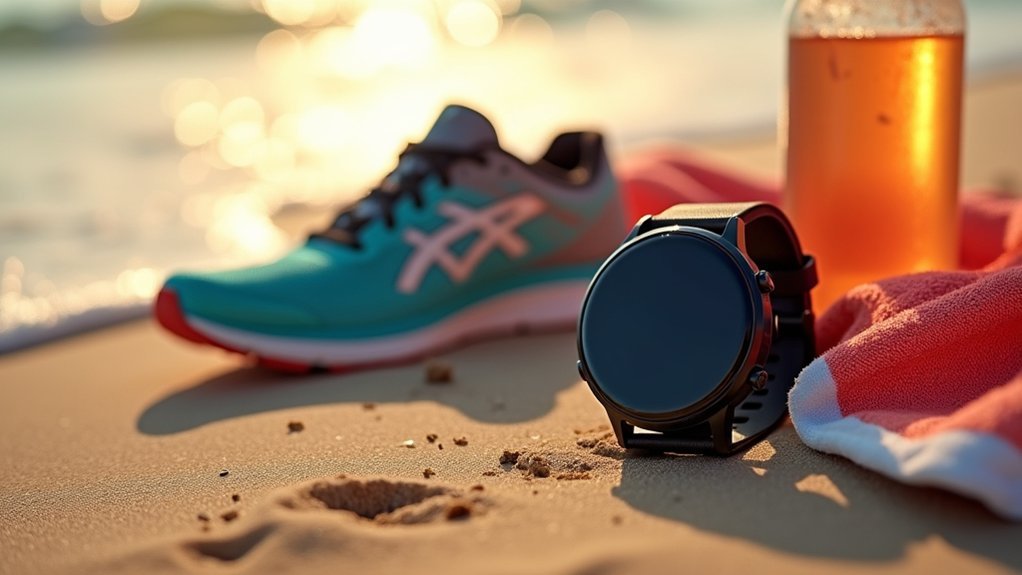

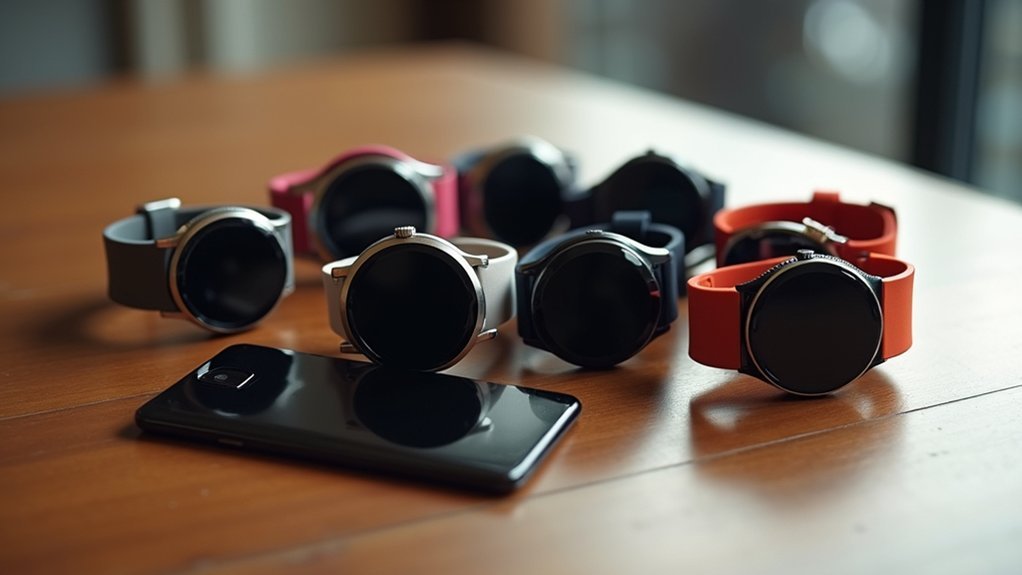
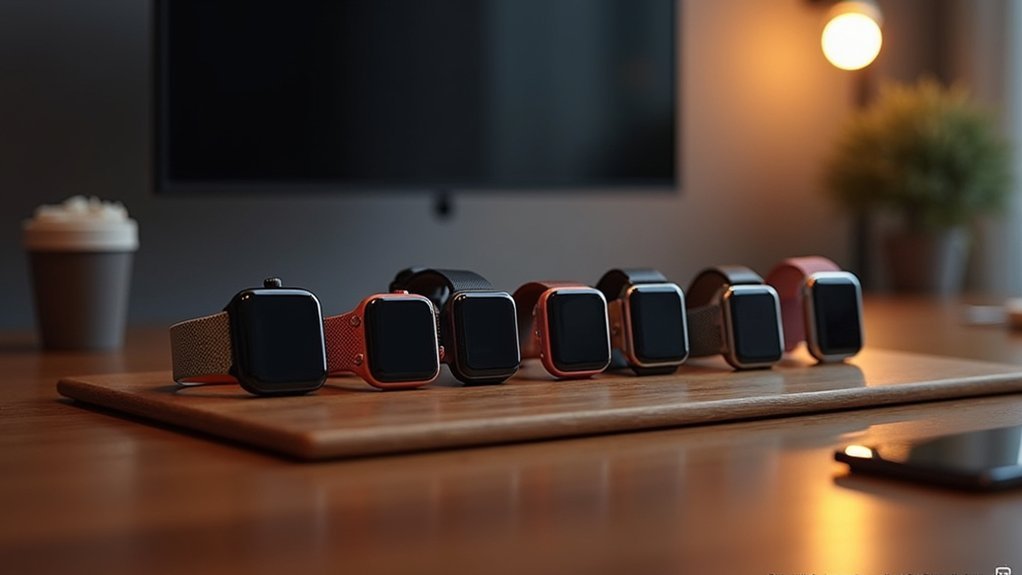
Leave a Reply